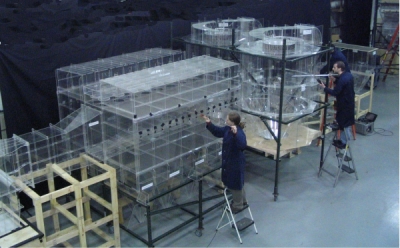Physical Lab Flow Modeling
Physical flow modeling involves the construction of scale models and running flow through the model. This allows Airflow Sciences engineers to assess equipment performance in a controlled environment, perform specific research to improve a process or product, and develop prototype equipment. Physical model results also provide input values and correlation data for our CFD simulations.
The physical models are usually constructed with clear walls or windows so that flow patterns can be observed via smoke flow, strings, or bubbles. Air is drawn through the scale models at a flow rate that provides similar fluid dynamic behavior to the full scale system. Flow characteristics are measured over a grid of traverse points using inserted probes to obtain values for velocity and pressure at select locations. Dust can be injected into a model to simulate the behavior of particulate in a system (to assess ash deposition, for example). Model results can be presented as color contours, histograms, or other plotting methods similar to field testing.

ASC fabricates physical flow models of various industrial equipment to analyze internal flows and develop design improvements. This includes:
- Pollution control devices: such as ESPs, SCRs, fabric filters, and cyclones
- Combustion systems: such as windboxes, burners, coal pipes, and ducts
- Thermal processes: such as auto engine parts, and transmission gears
- Manufacturing processes: such as quenching, CVD
- Food processing equipment
- HVAC systems
